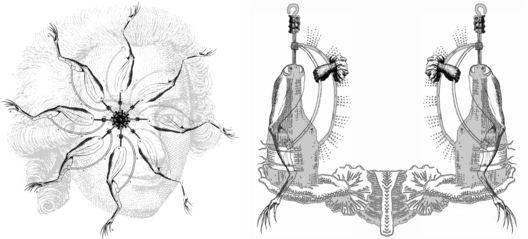Luigi Galvani1737–1798
After the initial enthusiasm, the confidence in the efficacy of electric medicine was fading. In this period, Galvani undertook a systematic study on the involvement of electricity in body functions and particularly in the physiology of nerves and muscles. This was in the line of “rational medicine” advocated in the seventeenth century by Malpighi and his followers, stating that medicine must be based strictly on the study of anatomy and physiology, and should not be a pure empirical enterprise. Initially Galvani applied an electric discharge from an electric machine or from a capacitor (Leyden jar or Franklin’s “magic square”) to the exposed crural nerve or muscle of an isolated frog’s leg and it twitched vigorously. The same happened also with the application of “natural” electricity produced during a thunderstorm. More significantly, the muscle twitched if nerves and muscle tissues were connected through a metal in the absence of any external source of discharge. This crucial observation was made while Galvani was trying to ascertain the efficacy of atmospheric electricity by hanging frog preparations from metal railings on a balcony. In his De viribus electricatis in motu musculary commentarius, first published in 1791, Galvani suggested that this was due to a special type of electrical fluid that accumulates in the muscles of animals (dubbing it “animal electricity” a phrase which first emerged in connection with Walsh’s research on electric fishes). He developed a model based on the idea of “the minute animal Leyden jar”. Electricity would be accumulated between the interior and exterior of a muscle fibre, and a nerve fibre would penetrate inside it, thus allowing for its discharge in physiological conditions. This mechanism would account for muscle contraction and nerve conduction. The impact of Galvani’s experiments were immediately evident causing (as was said in the scientific milieu of the time) a storm comparable to the turmoil produced by the French revolution in European society. Historically, it is in the context of ‘theoretical medicine’, and particularly physiology, that Galvani’s experiments had a lasting appeal, not least because of the debates they stirred. With Galvani’s research “animal spirits”, those elusive entities considered for millennia to be messengers of sensations and motion commands along nerves, were exiled forever from science and modern electrophysiology started to emerge. In the centuries to follow, electrophysiology would be one of the founding pillars of modern neurosciences.
